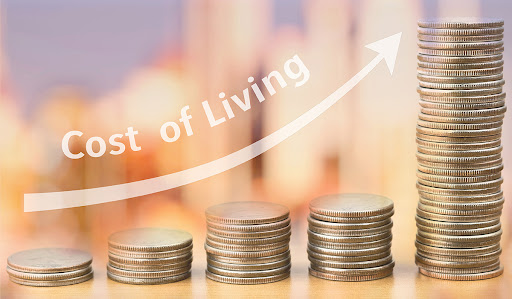Spencer Pruitt
Reporter
The cost of everyday expenses has skyrocketed this past year due to increasing inflation, costing students hundreds of extra dollars. A college student is now spending over $500 more a year on food, gas and other everyday items than they would have a year ago, according to recent inflation figures and recent gas prices.
Inflation is the average increase in prices of goods and services in the economy of the United States and represents the average of how much the cost of items have increased in price from a year prior. The average inflation rate for the year is 6.2%. Over the past 30 years the yearly inflation averaged was typically around 2.2%. This year inflation is over 4% higher than average, according to the 30 year inflation rates, provided by the U.S. Bureau of Labor Statistics. This means that everything people buy is now more expensive than it would have been a year ago. Every $100 spent last year is now on average costing the consumer $106.20, 6.2% more than last year, according to the Bureau.
The price of food has increased 7.9% from February 2021. Energy (primarily gas) has increased over 25% from February 2021 according to the Bureau. These increases of everyday expenses are being directly felt by everyone, including college students. Many students live on a budget that is determined at the beginning of the school year, and do not have regular sources of income while in school. Inflation rates impact these budgets, forcing many students to make essential cuts in their spending and budgeting, costing them hundreds of dollars more.
To put this in more detailed context, if you are someone spending $100 a month on food, and driving 25 miles a day or 175 miles a week, with a average fuel economy vehicle getting 25 miles per gallon, you are now spending over $630 more this year than you would have last year on the same exact expenses. That figure is just the price of inflation you would be paying which is in addition to the costs of the items.
Gas prices alone have increased over $1.50 a gallon since last year. On March 23, 2021 the average Washington State gallon of gas price was $3.24. A year later, on March 23 2022 the average Washington State gallon of gas price rose to $4.74 according to AAA Gas Prices, costing the average driver an additional $10-$25 a week.
What can people do to reduce these additional costs? First, they can plan and budget more, and factor in inflation and additional costs before making purchases or planning trips. People can consider changing their way of transportation, including utilizing public transportation, carpooling, walking, or biking instead of driving their own vehicle. They can also wait for possible reduced inflation rates as the economy changes, although lower inflation rates are not guaranteed.
Inflation rises can be caused by a variety of things: supply chain issues, increased demand for items, trade relationships between the U.S and other countries, energy dependency on other countries, and international and national events affecting the global economy. As citizens we have a voice, and can potentially help prevent rising inflation rates in the future. We can do this by researching elected politicians and considering political candidates’ economic policies and stances before casting a ballot.



















